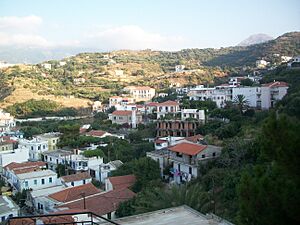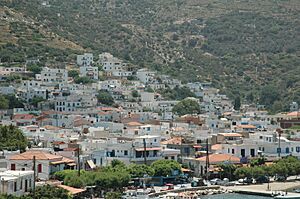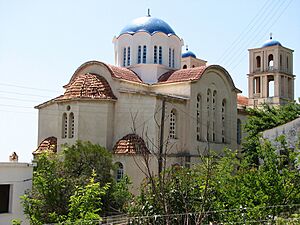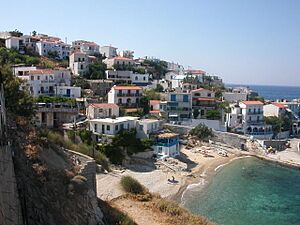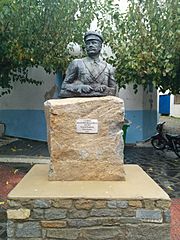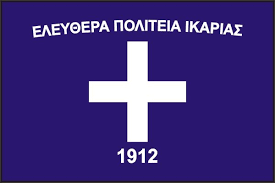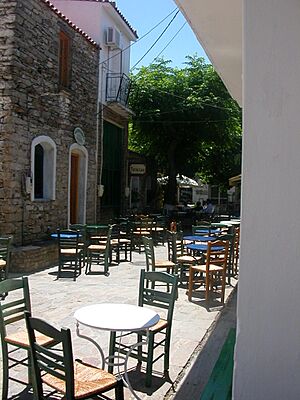Icaria facts for kids
Quick facts for kids
Icaria
Ικαρία
|
|
|---|---|
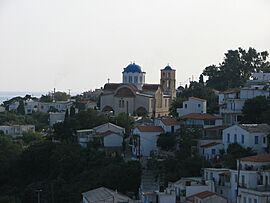
View of Agios Kirykos, Ikaria's capital
|
|
| Country | Greece |
| Administrative region | North Aegean |
| Regional unit | Ikaria |
| Area | |
| • Municipality | 255.3 km2 (98.6 sq mi) |
| Highest elevation | 1,037 m (3,402 ft) |
| Lowest elevation | 0 m (0 ft) |
| Population
(2021)
|
|
| • Municipality | 8,843 |
| • Municipality density | 34.638/km2 (89.711/sq mi) |
| Demonym(s) | Icarian |
| Time zone | UTC+2 (EET) |
| • Summer (DST) | UTC+3 (EEST) |
| Postal code |
833 xx
|
| Area code(s) | 22750 |
| Vehicle registration | MO |
Icaria, also called Ikaria (Greek: Ικαρία), is a beautiful Greek island. It is located in the Aegean Sea, about 12 miles (19 km) southwest of Samos.
Icaria is its own special area, called a municipality. It is part of the North Aegean region of Greece. The main town and capital of the island is Agios Kirykos. Long ago, the island's capitals were Oenoe and Evdilos.
The island gets its name from an old Greek story. It is said that Icarus, the son of Daedalus in Greek mythology, fell into the sea near here.
Contents
Island Geography and Climate
Icaria is one of the islands in the northern Aegean Sea. It covers about 98 square miles (255 square kilometers) and has 102 miles (164 km) of coastline. Around 8,312 people live on the island.
The island has both green hills and rocky, steep mountains. Most of Icaria is mountainous. The Aetheras mountain range runs through the island, with its highest peak reaching 3,402 feet (1,037 meters). Many villages are found near the coast, but some are hidden in the mountains.
Icaria is known for making strong red wine. Many parts of the island are covered in bushes, making it very green. You can find wild animals like martens, European otters, jumping spiders, and green toads. Icaria has a typical Mediterranean climate, with warm, dry summers and mild, wet winters.
Island History and Ancient Times
People have lived on Icaria since at least 7000 BC. The first people were the Neolithic Pelasgians. Around 750 BC, Greeks from Miletus came to Icaria. They built a settlement where Campos is today, which became the ancient capital of Oenoe. In ancient times, the island was called Icaria or Ikaria, just like today. It was also sometimes called Icarus or Ikaros.
Ancient Greek Influence
In the 6th century BC, Icaria became part of the sea empire of Polycrates. Later, in the 5th century BC, the Icarian cities of Oenoe and Thermae joined the Delian League. This was a group of Greek city-states led by Athens.
Around the 2nd century BC, people from Samos settled on the island. During this time, the Tauropolion, a temple for the goddess Artemis, was built in Oenoe. Coins from the city showed Artemis and a bull. There was also a smaller sacred place for Artemis Tauropolos at Nas, on the northwest coast.
The sea around Icaria was known to be dangerous in ancient times. The poet Homer wrote about its wild waves. The island itself had nicknames like ‘Dolichi' (meaning elongated) and ‘Ichtheoussa' (meaning rich in fish). Some believe the name Icaria might come from an old Phoenician word for fish, ‘ikor'.
Temple of Artemis at Nas
Nas was a special, sacred place for the people who lived in the Aegean before the Greeks. It was an important port where sailors would stop before sailing into the dangerous seas around Icaria. Sailors would offer gifts to Artemis Tauropolos, who protected them.
The temple was in good condition until the mid-1800s. Then, villagers from Kato Raches took its marble to build their local church. In 1939, a Greek archaeologist named Leon Politis dug up the church. During World War II, many items found by Politis disappeared. Local stories say that German and Italian soldiers stole them. People also say that marble pieces from the temple are still buried under the sand at Nas beach.
Medieval Era and Ottoman Rule

In the 1300s, Icaria was controlled by the Republic of Genoa. During this time, the Icarians destroyed their own ports. They did this to stop unwanted visitors from landing on the island.
Local historians say that Icarians built seven watchtowers along the coast. When an unknown ship appeared, observers would light a fire. They would also open a plug in a water tank. The water level would show how big the danger was. Other towers would see the fire and repeat the process, sending messages across the island. These watchtowers were part of a communication system that had been used since the time of the Delian League.
Icarians used to build their houses in a special way. Each house was small, with one room and a stone roof. Houses were far apart from each other. They had a single low door and tall walls facing the sea for protection. There was an opening on the roof called an Anefantis. Smoke from cooking would go out through the roof slabs, keeping the house hidden.
People slept on the floor and hid their things in the walls. Men and women wore similar simple clothes made of wool. This simple way of life helped Icarians live long lives. It also meant there were no clear social classes. Each house was self-sufficient, growing its own food. Women played a big part in work and social life.
Villages grew slowly, often from one family's descendants. Even with few people, the community was strong. They had panigiria (festivals with music and dancing), worked together, and had elder councils to make decisions. This unique way of life lasted until the late 1800s, and some parts still exist today.
Knights Hospitalier and Ottoman Control
The Knights of St. John, based in Rhodes, controlled Icaria until 1521. Then, the Ottoman Empire took over. During this time, piracy became a huge problem. The islanders used a clever trick: they became "invisible." They moved to the island's high mountains, hiding their villages and homes.
To protect themselves from pirates, they also used watchtowers and secret supply spots. Stealing from these shared supplies was a serious crime. Locals were known to attack any unwanted visitors, even shipwrecked sailors.
The Icarians even killed the first Turkish tax collector but avoided punishment. A local story says that when Turkish authorities asked who did it, the Icarians replied, "all of us, milord." The Turks decided it wasn't worth punishing everyone.
The Ottomans ruled Icaria very loosely. For centuries, they didn't send officials to the island. Later, they appointed local leaders called Kodjabashis to collect taxes. In 1677, Archbishop J. Georgirenes described Icaria as having about 1,000 strong, long-lived people. He said they were the poorest people in the Aegean Sea.
Icaria had no good port because the locals had destroyed them to stop pirate raids. The island traded with the outside world using small boats pulled onto beaches. Icarian boat-makers were known for building boats from the island's fir forests. They sold boats and wood in nearby Chios for money and grain. The waters around the island had the best cockle shellfish. Over time, Icaria also became famous for its charcoal, known as Ikarian Charcoal.
Goats and sheep roamed freely in the rocky landscape. Every household made its own cheese. In the 1600s, Icaria did not export wine. People stored wine in old-fashioned clay pots called pithoi, buried in the earth. This protected their wine from both tax collectors and pirates.
Unlike the crowded towns of Samos, Icarians lived separately in strong, simple farmhouses. Each house had a walled orchard and a garden.
In 1827, during the Greek War of Independence, Icaria broke away from the Ottoman Empire. However, it was not included in the new independent Greece. So, it had to accept Ottoman rule again a few years later.
The Free State of Icaria
|
Free State of Icaria
Ελευθέρα Πολιτεία Ικαρίας
|
|||||||||
|---|---|---|---|---|---|---|---|---|---|
| 1912 | |||||||||
|
Flag
|
|||||||||
|
Anthem: Anthem of Ikaria (Konstantinos Psachos/Fragiskos Carrer)
|
|||||||||
| Capital | Agios Kirykos | ||||||||
| Common languages | Greek | ||||||||
| Religion | Greek Orthodox | ||||||||
| Government | Republic | ||||||||
|
• President
|
Ioannis Malachias | ||||||||
| History | |||||||||
|
• Established
|
18 July 1912 | ||||||||
|
• Disestablished
|
4 November 1912 | ||||||||
|
|||||||||
| Today part of | |||||||||
Icaria was part of the Ottoman Empire until July 17, 1912. On that day, the Icarians forced the Turkish soldiers to leave and gained their independence. After this, the First Balkan War began. Icaria's only "warship," the Cleopatra, helped bring food and supplies to the islands of Samos and Chios. These islands were captured by the Greek Navy during the war.
George N. Spanos (born around 1872) from Evdilos is honored as a hero of the Icarian Revolution. He was killed in a Turkish ambush on July 17, 1912. You can see a statue of him at a memorial in Chrysostomos, an Icarian town.
On July 18, 1912, the Free State of Icaria was officially declared. The nearby islands of Fournoi Korseon also became free and joined this new state. Ioannis Malachias was the first and only president of the Free State of Icaria.
For five months, Icaria was its own independent country. It had its own government, army, flag, coat of arms, postage stamps, and national anthem. These five months were tough for the island's economy. There wasn't enough food, and there was a risk of Icaria becoming part of the Italian Dodecanese.
Finally, on November 4, 1912, Icaria officially became part of the Kingdom of Greece. The Ottoman Empire agreed to Greece taking Icaria and other Aegean islands in the Treaty of London (1913).
Second World War and "Red Rock"
The island suffered a lot during the Second World War. It was occupied first by Italian and then by German forces. Many people died from starvation. In the village of Karavostamo alone, over 100 people starved.
After the war, the Greek Civil War (1946–49) began. The Greek government used Icaria as a place to send about 13,000 communists. Even today, most Icarians support left-wing political parties. Because of this, some people call Icaria the "Red Rock" (Κόκκινος Βράχος, Kokkinos Vrahos).
Modern Icaria and Longevity
Life on Icaria got much better after 1960. The Greek government started to invest in the island's roads and other services to help tourism grow.
Today, Icaria is known as one of the world's five "Blue zones." These are places where people often live to be very old. On Icaria, about one in three people live into their 90s! This is thought to be because of their healthy diet, active lifestyle, and genetics.
Island Population and People
The people who live on Icaria are called Icarians or Icariots (Greek: Ικαριότες, Ikariótes).
Many Icarians live in other parts of Greece, especially on Thimena and Fournoi Korseon, and in Athens. Icarians can also be found all over the world, including Australia, the United States, Canada, Egypt, and the United Kingdom.
Icarian Greeks are closely related to other Greeks from the Aegean islands, like those from Samos, Chios, Fournoi Korseon, and Patmos. They also share connections with Greeks from Anatolia (modern-day Turkey).
Icaria's Municipality and Villages
The current municipality of Ikaria was formed in 2011. It brought together three smaller areas that used to be separate municipalities:
- Agios Kirykos
- Evdilos
- Raches
These areas are divided into smaller communities, which include many villages.
Museums on Icaria
Archaeological Museum of Kampos
This museum is in the village of Kambos. It stands on a hill where the ancient fortress of Oinoe once was. Right next to it is Agia Irini, the oldest church on Icaria. The museum has over 250 items. These include tools from the Stone Age, pottery, clay statues, columns, coins, and carved headstones.
Archaeological Museum of Agios Kirikos
This museum is in the old high school building in Agios Kirikos. The beautiful building was built in 1925 by Icarians living in America. It has been updated and now holds many important finds from Icaria. It also has a center for research and keeping old items safe.
The museum has screens and films about the Myth of Icarus and the ancient city of Drakano. It shows Icaria's archaeological discoveries. It helps visitors understand how the ancient settlements on Icaria grew and changed over time.
Folk & Historical Museum Of Agios Kirikos
This museum opened in Agios Kirikos in July 2010. It was created to save and share Icarian traditions and customs. It displays over 1,500 items that show the history and heritage of Icaria and its people.
The museum has old clothes, fabrics, household items, pottery, and farming tools. It also has photos, documents, and many other objects. A very special item is the flag of the Free State of Icaria from 1912. Some exhibits are organized by theme and time period. This helps visitors see what social and economic life was like on Icaria from the 1700s to the 1970s.
Folklore Museum Of Vrakades
The Folklore Museum of Vrakades is in the beautiful village of Vrakades. This village is 650 meters (about 2,130 feet) above sea level on the northwest side of the island. It was founded in the 1600s and has old stone houses and captains' villas. The museum has an interesting collection of items about the history and people of the area. It includes documents and memories from the Free State of Icaria.
Other items include clay and wooden tools used by housewives, beekeepers, and farmers. There are also church items, books by Icarian writers, and old Icarian records. You can see a "lanari," a tool used to process wool and goat hair for making clothes. There's also a "lisgos," a simple tool for making ropes, and other tools used by the island's first inhabitants.
Notable People from Icaria
- Eleftheria Arvanitaki (born 1957), a famous singer with family roots in Icaria.
- Ioannis Malachias (1880–1958), the first and only President of the Free State of Ikaria.
- Aristides Phoutrides (1887–1927), a professor of classical studies at Harvard University.
- Aris Poulianos (born 1924), an anthropologist born on Icaria.
- Zack Space (born 1961), an American politician whose family comes from Icaria.
- Christodoulos I. Stefanadis (born 1947), a professor of heart medicine, born on Icaria.
- Anthony Maras, a Greek-Australian film director.
- Chris Kourakis, the Chief Justice of South Australia.
- Mikis Theodorakis, a famous Greek composer who lived in exile on the island.
- Nick Mamatas, an American author whose family comes from Icaria.
- Yorgos Lanthimos, a Greek film director whose grandmother is from Icaria.
- Dean Karnazes, an American ultramarathon runner and author whose mother's family is from Icaria.
- Stephan Pastis, an American cartoonist.
- Jonathan Carapetis, an Australian children's doctor whose father is from Icaria.
- Tina Fey, an American actor whose grandmother was from Icaria.
See also
 In Spanish: Icaria para niños
In Spanish: Icaria para niños




